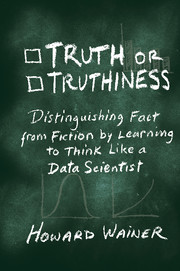Book contents
- Frontmatter
- Dedication
- Contents
- Preface and Acknowledgments
- Introduction
- Section I Thinking Like a Data Scientist
- Section II Communicating Like a Data Scientist
- 8 On the Crucial Role of Empathy in the Design of Communications: Genetic Testing as an Example
- 9 Improving Data Displays: Th e Media's and Ours
- 10 Inside Out Plots
- 11 A Century and a Half of Moral Statistics: Plotting Evidence to Aff ect Social Policy
- Section III Applying the Tools of Data Science to Education
- Section IV Conclusion: Don't Try Th is at Home
- Bibliography
- Sources
- Index
11 - A Century and a Half of Moral Statistics: Plotting Evidence to Aff ect Social Policy
from Section II - Communicating Like a Data Scientist
Published online by Cambridge University Press: 05 December 2015
- Frontmatter
- Dedication
- Contents
- Preface and Acknowledgments
- Introduction
- Section I Thinking Like a Data Scientist
- Section II Communicating Like a Data Scientist
- 8 On the Crucial Role of Empathy in the Design of Communications: Genetic Testing as an Example
- 9 Improving Data Displays: Th e Media's and Ours
- 10 Inside Out Plots
- 11 A Century and a Half of Moral Statistics: Plotting Evidence to Aff ect Social Policy
- Section III Applying the Tools of Data Science to Education
- Section IV Conclusion: Don't Try Th is at Home
- Bibliography
- Sources
- Index
Summary
It is a truth universally acknowledged, that any person in possession of a geographic data set, must be in want of a map.
Jane Austen 1817The sophisticated use of thematic maps began on November 30, 1826 when Charles Dupin (1784–1873) gave an address on the topic of popular education and its relation to French prosperity. He used a map shaded according to the proportion of male children in school relative to the size of the population in that départment. This graphic approach was improved upon in 1830 when Frére de Montizon produced a map showing the population of France in which he represented the population by dots, in which each dot represented ten thousand people. Although no one remarked on it for the better part of a century, this was perhaps the most important conceptual breakthrough in thematic mapping. It was the direct linear antecedent of John Snow's famous map of the 1854 cholera epidemic in London. Snow's map, presented in Figure 11.1, uses bars to show the location and number of cholera deaths, which Snow noted were centered around the Broad Street water pump. Even though the vectors of cholera contagion were unknown at that time, the spatial pattern of deaths relative to the water pump suggested to Snow the cause of the epidemic. He petitioned the Vestry of St. James to remove the pump's handle, and within a week the epidemic, which had taken 570 lives, ended. This may not be history's most powerful example of Tukey's observation about a graph being the best way to find what you were not expecting, but it is certainly among the top five.
Joseph Fletcher and Maps of Moral Statistics
Maps of moral statistics started appearing at about the same time; these typically focused on various aspects of crime. Most widely known were those of Adriano Balbi (1782–1848) and Andre-Michel Guerry (1802–66), whose 1829 map pairing the popularity of instruction with the incidence of crimes was but the start of their continuing investigations. Their work was paralleled by the Belgian Adolphe Quetelet (1796–1874), who, in 1831, produced a marvelous map of crimes against property in France, in which the shading was continuous across internal boundaries rather than being uniform within department. Guerry expanded his investigation in the 1830s to add three other moral variables (illegitimacy, charity, and suicides) to crime and instruction.
- Type
- Chapter
- Information
- Truth or TruthinessDistinguishing Fact from Fiction by Learning to Think Like a Data Scientist, pp. 122 - 138Publisher: Cambridge University PressPrint publication year: 2015



